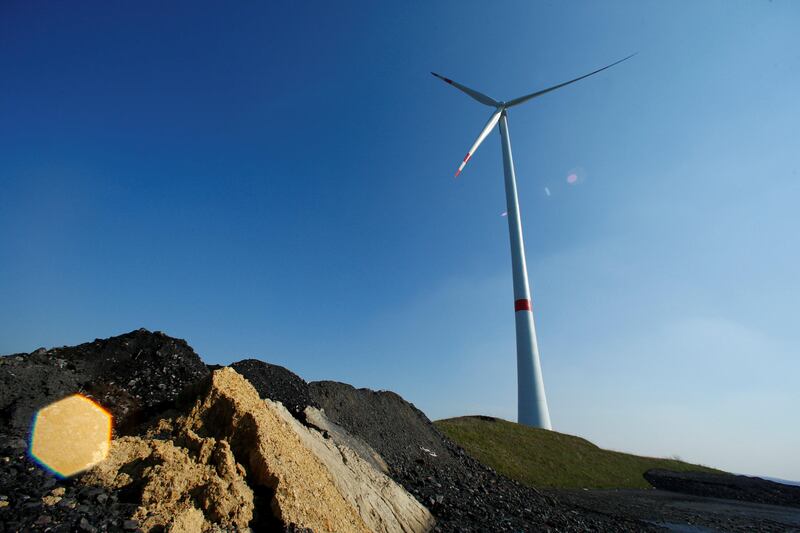Solar power isn’t the only form of renewable energy taking off in the Middle East. More wind projects are being tendered as the region looks to diversify its energy mix, according to Vestas, the world’s largest wind turbine manufacturer.
“Everyone thinks about solar photovoltaic (PV) in the Middle East," said Rainer Karan, Mediterranean East general manager for Vestas. "As more studies are completed and discussions move forward, there’s a high wind potential for the Middle East North Africa (Mena) region.”
Countries are bulking up their renewable energy sources to meet a rise in demand for power as they free up hydrocarbons for export. With the pivot towards a more cost efficient energy mix, there have been world-record breaking prices of solar PV power plants. That shift began with the second phase of the Mohammed bin Rashed Al Maktoum solar park in 2015.
How has #windpower technology improved since the first projects were built in the 1980's? pic.twitter.com/rdP2K5sbRU
— American Clean Power (ACP) (@USCleanPower) August 24, 2017
Last year was the first time ever that solar power projects superseded all other forms of new capacity added for renewable energy generation. It increased by 32 per cent to 71 gigawatts (GW), according to Abu Dhabi-based International Renewable Energy Agency (Irena). Wind power followed, growing 12 per cent and added 51GW of new projects worldwide.
The wind sector leads ahead of solar by about 56 per cent or 467GW of installations globally.
The two forms of renewable energy can be used in tandem.
________________
Read more:
[ Zarqa ties storage to its solar energy bids ]
________________
“Wind and solar are complementary renewable technologies,” Mr Karan said.
Governments in the region have congruently used areas to house both wind and solar projects. In Jordan's Al Shobak area, an EU-funded wind energy and concentrated solar power pilot project took off in 2010. The area is now home to a larger project, the 89MW Fujeij wind farm, which also contains Vestas’ turbines.
Jordan and Morocco are success stories for renewable energy developers. The stakes are higher for them, as they import the majority of their energy needs. Morocco had 979MW of wind and solar power installed in 2015, making up 12 per cent of its energy mix, which it plans to increase to 52 per cent by 2030.
________________
Read more:
[ Saudi Arabia looks past oil and pushes ahead with wind energy ambitions ]
________________
Though some countries have had success with the adoption of wind, others have faced difficulties.
Egypt, the most populous country in the Arab world, has struggled to increase its wind sector to meet its goal of adding 2GW of wind power to its grid by 2023. The country introduced a renewable energy feed-in tariff (FIT) to help incentivise investors. However, the fluidity of the Egyptian pound and liquidity issues within the country deterred some investors.
“We’re very motivated to go into these new markets, but the framework has to be there,” Mr Karan said. Though there had been interest it wasn't enough. The 2GW of wind power was under-subscribed in the tendering round.
Thirty-six companies have qualified for projects in the second tendering round, Lamya Hady, head of private projects sector at the Egyptian Electricity Transmission Company told The National.
________________
Read more:
[ Middle East is ‘Promised Land’ for renewable energy investment ]
________________
For Saudi Arabia, Opec's largest oil exporter, the first wind project was delayed in the wake of a new energy transformation programme as the project site had to be changed.
The wider GCC region has potential to generate more wind power. The UAE and Bahrain combined have 1.9MW of wind compared to 163MW of solar power from all the Gulf countries at the end of 2014, according to Irena.
Mr Karan believes the region will register more wind power penetration in the near future.
The potential of harnessing wind by some Gulf countries was highlighted by Irena last year.
“Parts of Kuwait, Oman and Saudi Arabia’s Red Sea coast have relatively high wind speeds,” according to the organisation. "More than 56 per cent of the GCC’s surface area has significant potential for wind deployment. Covering just 1 per cent of this area could translate into an equivalent 60GW of capacity.”
________________
Read more:
[ Irena says renewable energy costs set to tumble as UAE plays major role ]
[ World’s richest brands bet on the business case for renewable energy ]






